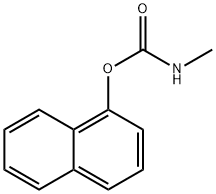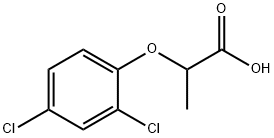PRODUCT Properties
| Melting point: | 142-146 °C (lit.) |
| Boiling point: | 315°C |
| Density | d2020 1.232 |
| vapor pressure | 2 (x 10-3 mmHg)at 40 °C (Meister, 1988) |
| refractive index | 1.5300 (estimate) |
| Flash point: | 202.7°C |
| storage temp. | Sealed in dry,Room Temperature |
| solubility | Moderately soluble in acetone, cyclohexanone, N,N-dimethylformamide (400–450 g/kg), and
isophorone (Windholz et al., 1983; Worthing and Hance, 1991) |
| form | Crystalline |
| pka | 12.02±0.46(Predicted) |
| color | Crystals |
| Water Solubility | Insoluble. 0.00826 g/100 mL |
| Merck | 13,1794 |
| BRN | 1875862 |
| Henry's Law Constant | (x 10-5 atm?m3/mol):
1.27 at 20 °C (approximate - calculated from water solubility and vapor pressure) |
| Exposure limits | NIOSH REL: TWA 5 mg/m3, IDLH 100 mg/m3; OSHA PEL: TWA 5
mg/m3; ACGIH TLV: TWA 5 mg/m3. |
| Stability: | Stable. Combustible; incompatible with strong oxidizing agents. |
Description and Uses
Carbaryl is a colourless to light tan or white or grey solid crystal depending on the purity of the compound. The crystals are essentially odourless and stable to heat, light, and acids but are not stable under alkaline conditions. It is non-corrosive to metals, packaging materials, and application equipment. Carbaryl is classified as a general use pesticide (GUP). It is sparingly soluble in water, but soluble in dimethylformamide, dimethyl sulfoxide, acetone, cyclohexanone, isopropanol, and xylene. Carbaryl is a wide-spectrum carbamate insecticide, which controls over 100 species of insects on citrus, fruit, cotton, forests, lawns, nuts, ornamentals, shade trees, and other crops, as well as on poultry, livestock, and pets. It is also used as a molluscicide and an acaricide. Carbaryl works whether it is ingested into the stomach of the pest or absorbed through direct contact. It is available as bait, dusts, wettable powders, granules, dispersions, and suspensions.
Labelled Prifinium Bromide, a synthetic antispasmodic drug; parasympatholytic. Prifinium Bromide is used as a quartenary anticholinergic agent.
Safety
| Symbol(GHS) |    GHS07,GHS08,GHS09 |
| Signal word | Warning |
| Hazard statements | H302+H332-H351-H400 |
| Precautionary statements | P202-P261-P273-P301+P312-P304+P340+P312-P308+P313 |
| Hazard Codes | Xn,N,F |
| Risk Statements | 22-40-50-67-65-50/53-38-11-20/22-20-43 |
| Safety Statements | 22-24-36/37-46-61-2-62-60-33-25-16-9 |
| RIDADR | UN 2811 6.1/PG 3 |
| OEB | B |
| OEL | TWA: 5 mg/m3 |
| WGK Germany | 3 |
| RTECS | FC5950000 |
| HazardClass | 6.1(b) |
| PackingGroup | III |
| HS Code | 29224999 |
| Toxicity | LD50 orally in rats: 250 mg/kg (Vandekar) |
| IDLA | 100 mg/m3 |



